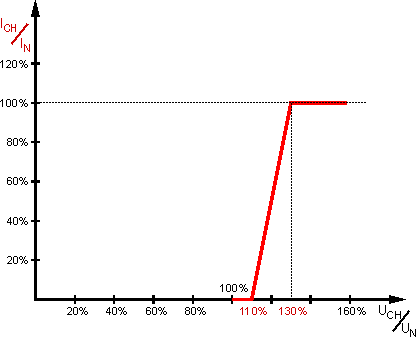Chopper operation
Instead of a DC motor, you can connect a brake resistor (chopper) to a channel of the KL2532/KL2552 and activate brake resistor mode for this channel (see KS2000 or registers R33.0 - R33.3).
The motor must actively brake for positioning tasks. The mechanical energy is thereby converted back into electrical energy. Small amounts of energy can be absorbed by a capacitor in the KL2532/KL2552. Further storage capacities, for example in the power supply, can also take up energy. The feedback leads in each case to a voltage increase.
In order to avoid overvoltage, a brake resistor can be connected to the KL2532/KL2552 in order to dissipate the excess energy in the form of heat. When the voltage reaches 110% of the rated voltage (register R36 , e.g. 55 V for KL2552), the correctly set output stage sends a fast-pulsed current through the brake resistor (see diagram).

|
UCH /UN |
20% |
40% |
60% |
80% |
100% |
110% |
130% |
160% |
|
UCH at UN = 50 V |
10 V |
20 V |
30 V |
40 V |
50 V |
55 V |
65 V |
80 V |
|
UCH at UN = 24 V |
4,8 V |
9,6 V |
14,4 V |
19,2 V |
24 V |
25,2 V |
31,2 V |
38,4 V |
Note | |
Dimensioning of the brake resistor The brake resistor should be dimensioned such that it can withstand the expected heat development without damage! |
A brake resistance of 10 Ω is recommended for KL2552, which results in a pulse current of approx. 5.5 A to 6.5 A. The maximum expected continuous power is 125 W. However, the value typically lies significantly below that.
Load estimation (for KL2552)
PN = IN² x R
PN = (5A)² x 10 Ω
PN = 250 W
A maximum duty cycle of 50 % is possible. This results in a maximum continuous power of 125 W.
A motor efficiency of 80 % is usual in practice.
The motor thus converts 80 % of the rated electrical power into kinetic energy when accelerating.
Conversely, when braking, the motor (as a generator) converts 80 % of the kinetic energy into electrical power.
This results in a practical brake power of:
PCH = PN/2 x 80/100 x 80/100
PCH = 125W x 80/100 x 80/100
PCH = 80 W